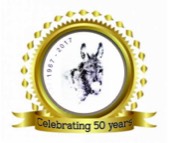A show slip with its sliding noseband is fine on fillies and some geldings but it certainly will not afford much control over a headstrong young colt, so it is never too soon to accustom them to wearing a correctly fitting bridle and bit and it is essential if your youngster is to grow up to respect his handler.
It is mandatory under Donkey Breed Society rules when showing a colt that the lead rein be attached to a bit.
A Shetland pony or small pony size bridle is most likely to fit, but donkeys are much broader on their heads than their pony counterparts, so you will need a cob size brow-band to fit without pinching around the sensitive areas at the base of the ears.
A bridle with brass buckles is attractive and a brass trimmed brow band will complete the look. If cost is less of an issue then your local saddler will undoubtedly be able to create a ‘made to measure version’ but will require some very accurate measurements from you or even a home visit to ensure that the bridle he crafts will fit correctly.
Special care should be taken with your choice of bit, this must fit comfortably without pinching the sensitive skin at the corner of the mouth, again donkeys are not the easiest candidates as their lip configuration is smaller than a pony of similar size which means that for the bit to be effective it will almost certainly wrinkle the corners of lips substantially; a bit dangling and rattling against the teeth is neither effective nor attractive.
For a youngster the weight of a metal bit may be quite upsetting in the early stages of training so a straight or slightly curved nylon bit with small brass rings is more appropriate, and even that needs to be introduced in a careful and sympathetic manner.
Many people favour attaching a single lead rein to the bit rings but it may be found more effective to buy a light pair of riding reins, attaching them as you would to a riding bridle, gather them into your hands some six inches from the chin to give balanced control over both side of the donkeys head.
Remember to practice leading your donkey on home territory before taking to the show ring. Walk beside your donkeys near-side shoulder, there will also be the requirement to ‘trot up’ and time spent teaching your donkey to stand up squarely will pay dividend. Avoid getting into any situation where the donkey is able to pull back or away from you.



